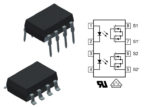Analog switch integrated chips (ICs), when turned on, will conduct both analog and digital signals from the input pin to the output pin. Digital switches can only accept digital signals and duplicate the logic level on the input pin at the output pin. When the digital switch is turned off, it returns to a default […]
FAQ
Analog comparators and hysteresis
A standard system requirement is to use the result of a simple “A vs. B” comparison as a basis for decision-making. For example, if the temperature is above a setpoint, turn the heat source off; and if the temperature is below that setpoint, turn the heat source on. Or perhaps there’s an alarm to sound […]
Nyquist rate basics and sufficient sampling for ADCs
Converting a real-world (analog) signal into a digital signal means that you have to bring the signal into an Analog-to-Digital converter (ADC). From there, the ADC turns the continuous analog signal into a discrete, digital signal by sampling, or taking regular snapshots of, the curves of the analog signal. After sampling is complete, any information […]
Selecting an op amp
You could start with a similar op amp from a similar, known-good circuit or reference design and extrapolate from there. However, not everything labeled a reference design has actually been built and tested. But there’s another way to get organized and feel in control of the selection process. A methodical approach is outlined below that […]
Compensating for DAC offset and gain error
Digital-to-analog converters (DACs) are subject to gain and offset error. Errors can be compensated for with hardware by using external components or by trimming the DACs after they have been manufactured. Trimming is necessary because the error is caused by mismatched resistors; trimming attempts to change resistor values in the DAC. However, some DACs can […]
Monotonicity: What is it and why is it important?
There are many parameters which define the performance of analog and mixed-signal circuits. Among the many “static” (sometimes called “DC” specifications, but this is a misnomer) factors are offset error, gain error, integral nonlinearity, and differential nonlinearity. Note that there are also dynamic specifications (called “AC” specifications but also a misnomer) such as the effective […]
Why use a nonlinear amp?
Users normally place a great deal of value in the high linearity of an amplifier and its corresponding low distortion. Audio amplifiers, for example, are quoted with many linearity specifications, such as total harmonic distortion (THD) or 1%, 0.1% or even less. Even the outputs of amplifiers with internal topologies which are inherently nonlinear, such […]
What is a multiplying DAC?
Multiplying digital-to-analog converters (MDACs) produce a (current) output signal that’s a product of the given reference voltage and the code (i.e., a string of 0s and 1s) flowing through it. All data converters require a voltage reference (VREF) and a typical, standard DAC needs a very stable fixed reference voltage in order to operate properly. […]
Optocoupler selection and usage for isolating a PWM
An optocoupler (or optoisolator) is a device that galvanically separates circuits and is not only great at isolation but allows you to interface to circuits with different ground planes or that operate at different voltage levels. Optocouplers are “fail safe” in that if subjected to voltages higher than the maximum rating, they are known to […]
What does an analog driver/buffer do?
The term “buffer” has many definitions in electronics hardware and software. It can be a reserved software area where data is temporarily stored until it is processes; a set of internal IC registers where data is queued before being transmitted or after it has been received; or it can be a circuit function interposed to […]










